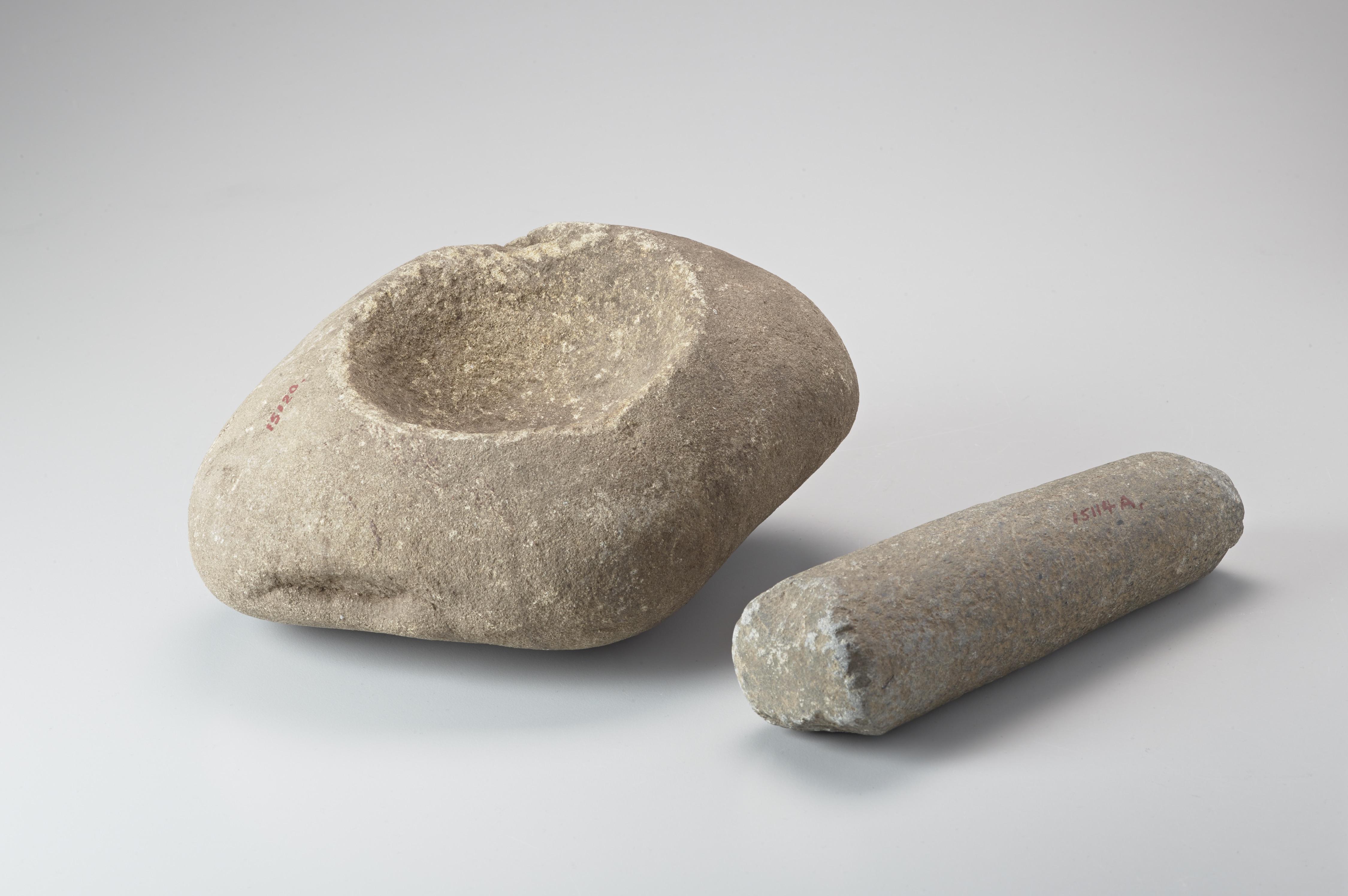Cantor Arts Center
328 Lomita Drive at Museum Way
Stanford, CA 94305-5060
Phone: 650-723-4177
CHRISTINA J. HODGE, Academic Curator and Collections Manager, Archaeology Center, and LAURA JONES, Director of Heritage Services and University Archaeologist with contributions by CHARLENE NJIMEH (Chair) and MONICA ARRELANO (Vice-Chair), Muwekma Ohlone Tribe

Artist unknown (U.S.A.) Ohlone Mortar and Pestle, n.d. Courtesy of the Stanford University Archaeology Collections of the Stanford Archaeology Center, Stanford University
In this place, on these lands, time starts before memory. This deep and ongoing story belongs to the Ohlone people and the local Muwekma Ohlone Tribe of the San Francisco Bay Area, who explain that Ohlone people have been here since time immemorial. Their tribe represents “all the known surviving lineages aboriginal to the San Francisco Bay region who trace their ancestry through the Missions Dolores, Mission Santa Clara, and Mission San Jose; and who were also members of the historic Federally Recognized Verona Band of Alameda County.” Ohlone ancestral, un-ceded territories comprise much of the lands surrounding the San Francisco Bay, including those of Stanford University.
With this declaration, the tribe members constitute themselves through place and family. These twin anchors held fast through colonial violence and systematic attempts at eradication that began in the late eighteenth century. With the tribe’s help, Stanford University has grown in understanding this history and its own accountability. Today, the Muwekma Ohlone Tribe has become one of the institution’s most important partners.
In the deep past, indigenous Bay Area communities lived in dozens of distinct villages across a productive landscape, which they understood and managed. Each group had recognized homelands, but each village was also multicultural, as young people were required to marry partners from outside their home villages. Over thousands of years, ancestral Ohlone left tangible signs across their homelands through artifacts, buried features, and changes to the land itself. Stanford University cares for many such sites. Alongside tribal knowledge, archaeological evidence contradicts the notion that European and US occupiers found a western “wilderness.” They entered a dynamic world susceptible to violent disruption.
In 1769, Spain claimed California lands by sending Catholic missionaries and invading armies, inaugurating a catastrophic era of compulsory labor, disease and deprivation, and the imposition of Christianity. The Ohlone were among those forced to labor for Crown and Church in missions, in presidios, and on Ohlone lands seized and granted by the Crown to its faithful soldiers. The Ohlone people maintained a forceful resistance against Spanish occupation for decades. Even as their situation grew more perilous under Mexican and US rule in the nineteenth century, leading them to eventually hide their Indian identity, language, and customs, they survived, returning to ancestral lands and forming new communities. The largest of these was in Pleasanton in the East Bay hills, where hundreds of Ohlone and their relatives from neighboring tribes gathered at the Alisal Rancheria and made a valiant attempt to regain their independence at the turn of the century. But their land claims were not respected. They were evicted and the village was burned to the ground.
The Muwekma Ohlone still struggle today with the consequences of US colonial policies that ignored their land claims and encouraged assimilation. Their continuing solidarity and resilience as a community are remarkable. The tribal government continues to advocate for their rights with local, state, and federal government agencies. While living fully modern lives in our Bay Area cities, Ohlone people gather and prepare traditional foods, teach the children their traditions and the Chochenyo language, and advocate for the preservation of sacred sites.
Stanford’s reeducation about Muwekma history began in the 1980s with difficult conversations about the return of thousands of ancestral human remains and funerary objects excavated by Stanford faculty and stored in the basement of the former Leland Stanford Junior Museum (now the Iris & B. Gerald Cantor Center for Visual Arts). Stanford repatriated the human remains and funerary objects to the Ohlone in 1988 for reburial. This history makes the museum a powerful place in Ohlone memory. Today, the university and tribe are strong partners in community-led archaeology, historic interpretation, and a Native plant garden.
Former Muwekma tribal chairwoman Rosemary Cambra stresses her tribe’s survivance: “Our people, the Muwekmas, the East Bay families, have never left their lands. They have always been here for generation after generation.” Today, tribal members remain connected to their homelands—including Stanford, which has dedicated residential space for indigenous students known as Muwekma-Tah-Ruk—The House of the People.